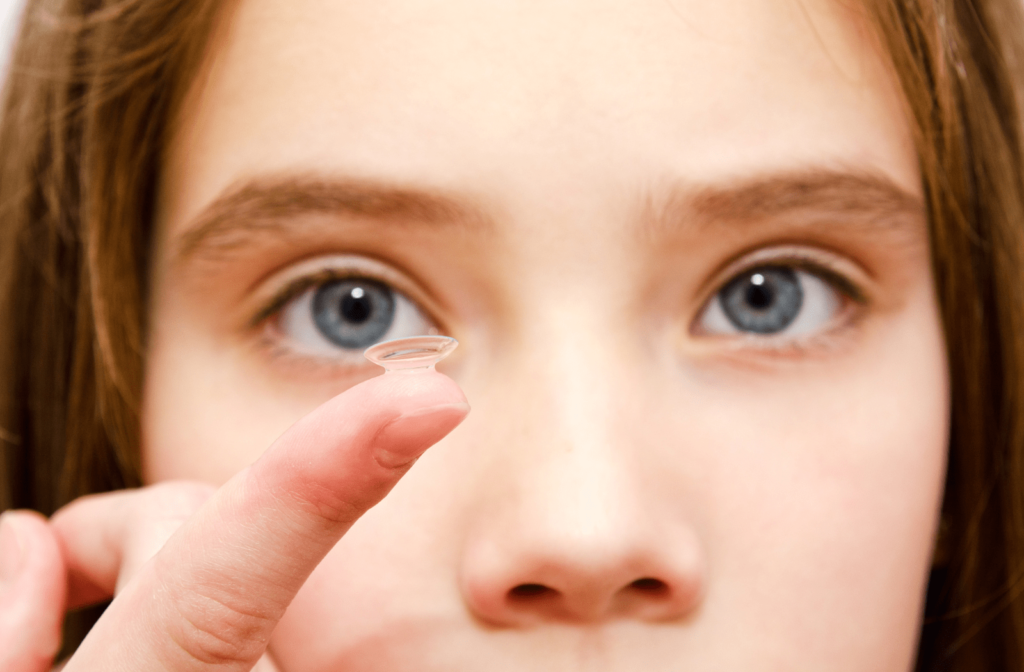There has been a rapid global rise in the prevalence of myopia or nearsightedness. Since our eyes continue to develop as we age, major changes occur between 6 and 18 years.
When children develop myopia at a younger age, there’s a higher risk factor for myopia progression. Regular children’s eye exams become more important to check for the presence of myopia and monitor changes.
The American Academy of Ophthalmology recommends the following schedule for eye exams in children:
- Birth to 2 years: First eye exam
- 2 to 5 years: At least one eye exam
- 6 to 19 years: Annual eye exams
While there is no cure for myopia, there are ways to slow its development. One option is MiSight contact lenses, designed especially for children.
What Is Myopia?
Myopia, or nearsightedness, is the most common refractive error in children. If you have myopia, you can see clearly close up, but objects at a distance appear blurry.
Causes of myopia include a too-long eyeball or too curved cornea, the outer layer of the eye. These prevent light from focusing directly on the retina, and images focus in front of the retina.
As children grow, their eyes can elongate even more to compensate for the lack of focus until they need −5 dioptres (D) or more of spherical correction. This progression or severe type of myopia is called high myopia.
High myopia increases your risk of developing other eye diseases, such as glaucoma, retinal tears, retinal detachment, cataract, and myopic macular degeneration.
Symptoms of Myopia
Apart from noticing distant vision is blurry, here are other symptoms of myopia:
- Headaches
- Squinting
- Eye rubbing
- Blinking often
- Eye strain that causes eye pain
- Difficulty reading or seeing the whiteboard at school
Treatment for Myopia
Options for myopia treatment include corrective glasses, contact lenses, or refractive eye surgery. Prescription corrective lenses help focus light on the retina. For myopia, a prescription is a negative number. The higher the negative number, the stronger the lens power.
Since there is no cure, slowing down the progression of myopia in children is the goal. Atropine eye drops have proved effective in slowing myopic progression. But require glasses or contact lenses to correct vision.
Specialty myopia-controlling eyeglass lenses also aim to slow down myopia and correct refractive errors. Consult your eye doctor for recommendations on the best type of treatment for individual needs.
MiSight Contact Lenses
MiSight contact lenses are the first contact lens indicated to slow myopia progression approved by the U.S Food and Drug Administration. It’s for children to initiate wear between 8 and 12 years.
MiSight contact lenses are soft contact lenses, single-use and disposable, providing more comfort. They also have 2 corrective powers :
- One corrects nearsightedness, improving distant vision.
- The other has concentric rings that help focus some of the light in front of the retina. It reduces the signals sent to the eye’s peripheral vision to stop growing.
Benefits of Choosing MiSight Contact Lenses
- Good hygiene: Misight contact lenses are for daily use and discarded at the end of the day. They require no lens care, disinfecting, or storing, which makes them ideal and convenient for children to prevent infection, ensure good hygiene, and have healthy eyes.
- Comfort: Misight contact lenses are soft contact lenses and thus provide more comfort with easy wear than rigid contact lenses for myopia control.
- Clearer vision: Misight contact lenses offer clearer vision than glasses, but they also have the added benefit of slowing down myopia progression and reducing axial elongation.
- Age: MiSight contact lenses can help control myopia in children as young as 8.
- No interruption in treatment: Since MiSight contact lenses are for daily wear, losing lenses won’t affect treatment. Ortho-K contacts, in comparison, are custom-made.
- Immediate results: Ortho-K lenses are rigid lenses and may take a few days for the cornea to adjust and vision to improve. MiSight contact lenses can provide immediate clear vision.
- Lower risk: MiSight contact lenses can minimize the long-term impact of myopia progression and lower your risk for developing sight-threatening eye conditions later in life.
Slowing Myopia Progression with MiSight
Myopia control includes many treatment options, including Ortho-K, atropine eye drops, multifocal contact lenses, and specialty eyeglasses. And now MiSight contact lenses.
If your child is showing symptoms of myopia, book an appointment with the optometrists at 2020 Eyecare Ohio. A children’s eye exam can detect signs of myopia with a better chance of initiating early treatment and slowing the progression.



